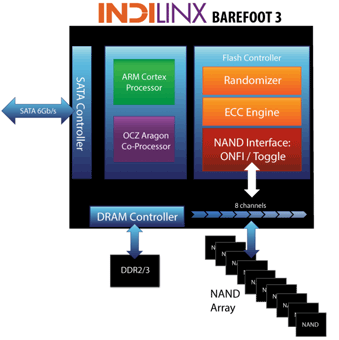Specifications & Features
Specifications & Features
The sample that AMD submitted is the most popular selling volume size of for SSDs, the 240GB version . This series is equipped with Toshiba MLC NAND, flash memory from the A19nm node. The NAND flash used is labeled: TH58TEG70DKA4C, very similar to the OCZ ARC 100 series. This product is fa notch aster though as it has been tweaked a little, and that will show in performance.
AMD will release three models within the Radeon R7 range, 120 GB, 240 GB and a 480 GB version. Due to the architecture and memory channels used, the 120 GB edition will be a notch slower albeit that is a very modest performance difference. This is pretty much the thumb of rule for any brand BTW. Still a 120 GB SSD performing at 550 MB/sec read and 470 MB/sec write performance remains exceptionally fast, especially if you keep the price in mind as starting at 240GB you are seeing 50 cents (USD) per GB, say 40 to 45 cents per GB in EURO. These obviously are suggested retail prices, it would be save to shave off another 10%
- SATA 3 - 6Gbp/s Interface
- 19nm Toshiba NAND Flash
- 7mm form factor
- 120 GB, 240 GB and 480 GB models
- Performance and endurance without compression/loss of usable capacity
- Lower Power consumption IDLE 0.6 W / Active 3.45 W
- TRIM support
- 3 Year Warranty
The Barefoot 3 M10 controller
The flash memory is tied towards the Indilinx (owned by OCZ Storage solutions) Barefoot 3 controller located under product code Barefoot 3 M10. This is an 8-channel NAND flash controller and the third revision from Indilinx, it comes with an all too familiar dual-core ARM architecture. The Barefoot 3 controller makes used of a pretty big memory partition for caching, that means that internal DDR3 memory plastered and hammered shut onto the PCB being used as file and data cache. The SSD has 512 MB of cache divided over two 256 MB ICs from Micron, but as we'll show you later on in the photo shoot, there is room for more. On the next pages we'll be showing you some PCB photo's as well, and what you'll notice is that it carries DDR memory caches as well. In-between the different SKUs the 240 GB has a 512 MB buffer, and some write speed variation with the lower capacity model.

Block diagram of the OCZ Barefoot 3 controller




